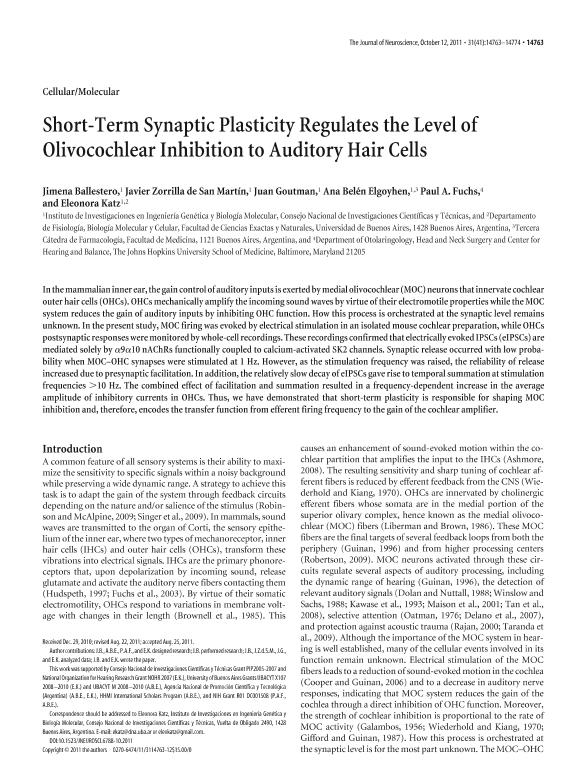Artículo
Short-term synaptic plasticity regulates the level of olivocochlear inhibition to auditory hair cells
Ballestero, Jimena Andrea ; Zorrilla de San Martín, Javier
; Zorrilla de San Martín, Javier ; Goutman, Juan Diego
; Goutman, Juan Diego ; Elgoyhen, Ana Belen
; Elgoyhen, Ana Belen ; Fuchs, Paul A.; Katz, Eleonora
; Fuchs, Paul A.; Katz, Eleonora
 ; Zorrilla de San Martín, Javier
; Zorrilla de San Martín, Javier ; Goutman, Juan Diego
; Goutman, Juan Diego ; Elgoyhen, Ana Belen
; Elgoyhen, Ana Belen ; Fuchs, Paul A.; Katz, Eleonora
; Fuchs, Paul A.; Katz, Eleonora
Fecha de publicación:
10/2011
Editorial:
Society for Neuroscience
Revista:
Journal of Neuroscience
ISSN:
0270-6474
Idioma:
Inglés
Tipo de recurso:
Artículo publicado
Clasificación temática:
Resumen
In the mammalian inner ear, the gain control of auditory inputs is exerted by medial olivocochlear (MOC) neurons that innervate cochlear outer hair cells (OHCs). OHCs mechanically amplify the incoming sound waves by virtue of their electromotile properties while the MOC system reduces the gain of auditory inputs by inhibiting OHC function. How this process is orchestrated at the synaptic level remains unknown. In the present study, MOC firing was evoked by electrical stimulation in an isolated mouse cochlear preparation, while OHCs postsynaptic responses were monitored by whole-cell recordings. These recordings confirmed that electrically evoked IPSCs (eIPSCs) are mediated solely by α9β10 nAChRs functionally coupled to calcium-activated SK2 channels. Synaptic release occurred with low probability when MOC-OHC synapses were stimulated at 1 Hz. However, as the stimulation frequency was raised, the reliability of release increased due to presynaptic facilitation. In addition, the relatively slow decay of eIPSCs gave rise to temporal summation at stimulation frequencies >10 Hz. The combined effect of facilitation and summation resulted in a frequency-dependent increase in the average amplitude of inhibitory currents in OHCs. Thus, we have demonstrated that short-term plasticity is responsible for shaping MOC inhibition and, therefore, encodes the transfer function from efferent firing frequency to the gain of the cochlear amplifier.
Palabras clave:
Outer Hair Cells
,
Synaptic Plasticiy
,
Cochlea
,
Efferent Innervation
Archivos asociados
Licencia
Identificadores
Colecciones
Articulos(INGEBI)
Articulos de INST.DE INVEST.EN ING.GENETICA Y BIOL.MOLECULAR "DR. HECTOR N TORRES"
Articulos de INST.DE INVEST.EN ING.GENETICA Y BIOL.MOLECULAR "DR. HECTOR N TORRES"
Citación
Ballestero, Jimena Andrea; Zorrilla de San Martín, Javier; Goutman, Juan Diego; Elgoyhen, Ana Belen; Fuchs, Paul A.; et al.; Short-term synaptic plasticity regulates the level of olivocochlear inhibition to auditory hair cells; Society for Neuroscience; Journal of Neuroscience; 31; 41; 10-2011; 14763-14774
Compartir
Altmétricas



